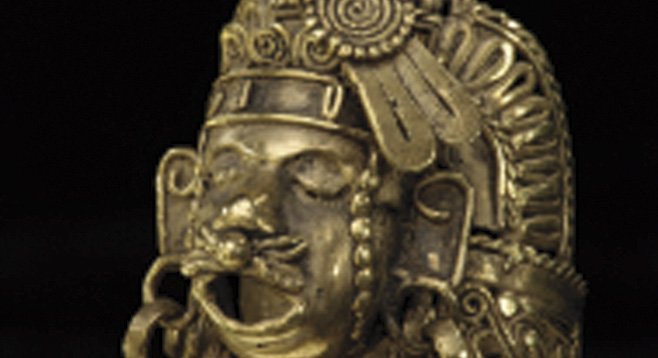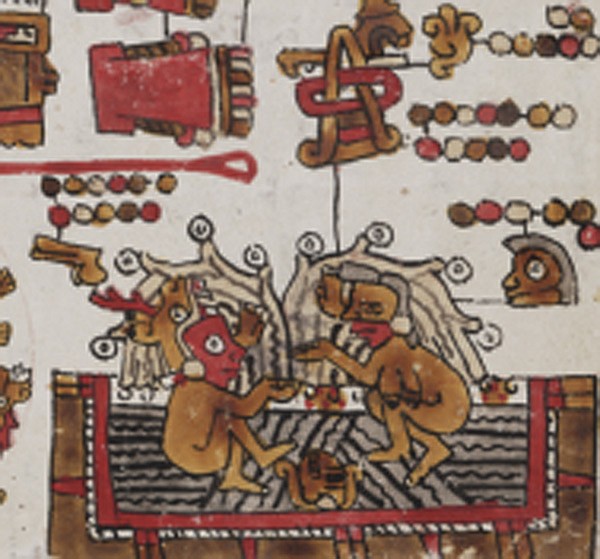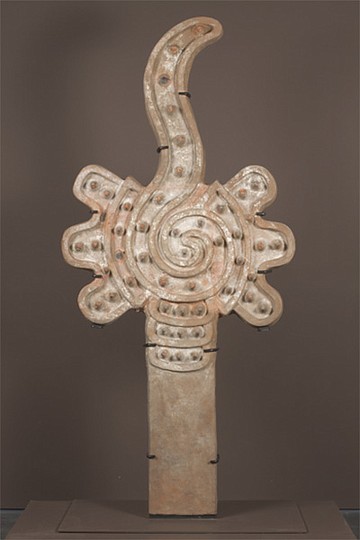 Facebook
Facebook
 X
X
 Instagram
Instagram
 TikTok
TikTok
 Youtube
Youtube

D.H. Lawrence believed that the earth and sky gods are still with us, active in what he called our “blood consciousness,” but have been repressed by Christian “education.” In his novel The Plumed Serpent, two political leaders in Mexico foment revolution by trying to reintroduce into a settled Christian social-political order three ancient Mexican gods. One of these is Quetzalcoatl, the bird-snake deity named after the fabulously colorful Resplendent Quetzal. In images of this deity excavated from ruins and found among temple pictographs and in codices (storyboard-style narratives), we see the bird’s curved, rib-cage-shaped wing-feathers and, in some instances, the faded glories of its dazzling turquoise and scarlet coloring.
In the first edition of The Plumed Serpent (1926), Lawrence included a long series of poems that he adapted, in his hammering manner, from translations of Aztec hymns. He had a true feeling for the elemental dynamics of indigenous lore, and the poems articulate them with trembling force. Here are lines from “The Living Quetzalcoatl”: “Out of the depths of the sky, I came like an eagle./ Out of the bowels of the earth like a snake./ All things that lift in the lift of living between earth and sky, know me./ The roots are mine, down the dark, moist path of the snake./ And the branches are mine, in the paths of the sky and the bird,/ But the spark of me that is me is more than mine own.” This gives a fair idea of the god’s encompassing, majestic ferocity.
The Feathered Serpent, along with its associated gods and goddesses, has lived in Mesoamerica’s soul-life for millennia, and its life is illustrated by the artifacts in Children of the Plumed Serpent, currently at the Los Angeles County Museum of Art. According to legends, in the 10th Century, Quetzalcoatl, the human incarnation of the Plumed Serpent God, founded and ruled over the great mercantile and religious center of Tollan (or “Place of Reeds,” now Tula, northwest of Mexico City). Quetzalcoatl, as the story goes, was expelled from Tollan after being corrupted by a rival; the civil war that ensued destroyed the city around 1200. In exile, the man-god journeyed throughout Southern Mexico and was adopted by a confederacy of trading partners as their patron deity. These communities referred to themselves as Children of the Plumed Serpent. They didn’t just share the cult of Quetzalcoatl, they also made up the most sophisticated and efficient network of commerce in the Americas, trading shells, gemstones, ceramics, parrot feathers, and cacao.
The cult reached its apotheosis in Cholula, a holy pilgrimage site and capital of a realm that covered 350 square miles and included 49 subject kingdoms. A Spanish magistrate wrote in 1580 that Cholula was “as greatly venerated as Rome is in Christianity and Mecca among the Moors.” Quetzalcoatl had the power to confer the divine right to rule: a royal who inherited a kingdom would journey to Cholula to receive ritual piercings of nose, earlobes, and lower lips for ornaments that confirmed his right to rule. The exhibition includes a panel from one of Cholula’s codices depicting an aspiring lord writhing beneath a priest who is pushing a long-bladed knife through his nose. And two pectorals (small breastplates) carved from shell depict other kinds of bloodletting associated with divination. One figure is sticking a knife through his tongue; another is inflicting some real unpleasantness upon his penis.
The Children of the Plumed Serpent traded with communities as far south as Central America, where they bartered for ceramic vessels and gold, and as far north as Southern New Mexico, where they acquired much-coveted turquoise to craft jewelry, mosaic pictographs, and other objects. The exhibition includes human skulls partially covered with tiny turquoise tesserae. (There’s a straight historical line from them to contemporary Day of the Dead calaveras.) The skulls fuse the elemental to the glorious, our awareness of mortality to our desire to find favor with the gods. They also blow the cover of those who claimed original genius for the diamond-encrusted skull the British artist Damien Hirst brought to market in 2007. His asking price: 50 million pounds.
In time the trading confederacy developed what came to be called the International Style. Their clayware shared a bright, varied palette and a vocabulary of icons that served as a common pictographic system; this allowed cultures that spoke different tongues to communicate with each other and to propagate their common belief system. Four ceramic plates from Cholula are elegant, beautifully preserved examples of the International Style. There’s a monkey, a deer, and a dog. The fourth wouldn’t let me look away: it bears a delicately involuted butterfly motif that doesn’t so much depict the creature as articulate its essences — lightness, loftiness, gorgeous fragility.

The meanings of imagery to the peoples who made them are like veils that fade or decay and are replaced by others. Xipe Totec is one of many gods whose identities have changed over time. Because he’s represented wearing (or somehow associated with) flayed human skin, he was long ago thought to be a fertility deity: the flayed skin represented shed husks out of which life renews itself. He has also been associated with goldsmiths, because the extraction process involves casting off impurities. More recent cultural markers have persuaded scholars that Xipe Totec was a war god. Among the Children of the Plumed Serpent, warriors rose in social status by killing enemies, and captives were flayed for their trophy-hides. A recently discovered full-body clay sculpture of Xipe Totec shows him dressed in a flayed human skin (it looks like fleecy long johns) and bearing an open-mouthed face that exults with jubilant triumph. And a tiny Mixtec pendant — you could clutch it in your fist — depicts Xipe Totec as a terrifying presence.

That pendant was made from spondylus (or spiny oyster) shell, a highly valued commodity in the confederation; it has a lustrous, marbled coral color. The most extravagant item in the exhibition is a shimmering regal tunic made from hundreds of such shells. Such a thing must have brandished potent juju when light rippled across its drapery of swaying, dangling tiles. Quetzalcoatl cultures had a coherence foreign to us. Material splendor, religious worship, bloodletting, image-making, warfare, human sacrifice, the animal orders, life and afterlife — everything conversed with everything else. Enormous cruelty was bound up with enormous devotional piety, and supremacy in war-making was attached to social elitism.
It’s no surprise that a deity like Xipe Totec should be associated with gold and the social elite. Gold and silver ornaments — the exhibition offers stunningly detailed rings, earrings, and pendants — weren’t just decorative, they were sacred, because they were remnants of the sun and moon. Members of the ruling class who wore them were representatives of the gods, intermediaries between deities and humans. This same elite also knew how to throw a party. To judge by scenes and figures depicted in codices and clayware, their feasts were elaborate and wild. Poets recited tribal histories and royal genealogies. Nobles in costume sang and danced. And the elite did surely love their pulque — one of many heady beverages fermented from agave — and also their hallucinogens, chased with chocolate. The possessed could summon ancestors and ask them for wisdom, how to resolve tribal disputes or make an ideal alliance through marriage. One pulque vessel, which like so many things in the Quetzalcoatl cult combines the ferocious with the visionary, is shaped in the form of the goddess Mayahuel: she’s been decapitated, her head falling backward as octli (the Nahuatl word for pulque) flows from her breasts into a pot.
Children of the Plumed Serpent dazzles and informs. But be advised that the essays in the extravagantly illustrated catalog are an unhelpful, pompous snooze. They’re tediously over-specialized (“The Effigy Censers of Mayapan”) and pedantic (“The Burned Palace of Tula: Its Offerings and Probable Function”). The meaning of the riches on display is nowhere discussed. As a longtime interested amateur, I pined for detailed information about the Plumed Serpent cultures, I craved more ethnographic speculation about the relationship between bloodshed and the sacred, I wanted more of what D.H. Lawrence happily ranted about.
Children of the Plumed Serpent: The Legend of Quetzalcoatl in Ancient Mexico is on view at the Los Angeles County Museum of Art until July 1. 5905 Wilshire Boulevard. 323-857-6000; lacma-org/


D.H. Lawrence believed that the earth and sky gods are still with us, active in what he called our “blood consciousness,” but have been repressed by Christian “education.” In his novel The Plumed Serpent, two political leaders in Mexico foment revolution by trying to reintroduce into a settled Christian social-political order three ancient Mexican gods. One of these is Quetzalcoatl, the bird-snake deity named after the fabulously colorful Resplendent Quetzal. In images of this deity excavated from ruins and found among temple pictographs and in codices (storyboard-style narratives), we see the bird’s curved, rib-cage-shaped wing-feathers and, in some instances, the faded glories of its dazzling turquoise and scarlet coloring.
In the first edition of The Plumed Serpent (1926), Lawrence included a long series of poems that he adapted, in his hammering manner, from translations of Aztec hymns. He had a true feeling for the elemental dynamics of indigenous lore, and the poems articulate them with trembling force. Here are lines from “The Living Quetzalcoatl”: “Out of the depths of the sky, I came like an eagle./ Out of the bowels of the earth like a snake./ All things that lift in the lift of living between earth and sky, know me./ The roots are mine, down the dark, moist path of the snake./ And the branches are mine, in the paths of the sky and the bird,/ But the spark of me that is me is more than mine own.” This gives a fair idea of the god’s encompassing, majestic ferocity.
The Feathered Serpent, along with its associated gods and goddesses, has lived in Mesoamerica’s soul-life for millennia, and its life is illustrated by the artifacts in Children of the Plumed Serpent, currently at the Los Angeles County Museum of Art. According to legends, in the 10th Century, Quetzalcoatl, the human incarnation of the Plumed Serpent God, founded and ruled over the great mercantile and religious center of Tollan (or “Place of Reeds,” now Tula, northwest of Mexico City). Quetzalcoatl, as the story goes, was expelled from Tollan after being corrupted by a rival; the civil war that ensued destroyed the city around 1200. In exile, the man-god journeyed throughout Southern Mexico and was adopted by a confederacy of trading partners as their patron deity. These communities referred to themselves as Children of the Plumed Serpent. They didn’t just share the cult of Quetzalcoatl, they also made up the most sophisticated and efficient network of commerce in the Americas, trading shells, gemstones, ceramics, parrot feathers, and cacao.
The cult reached its apotheosis in Cholula, a holy pilgrimage site and capital of a realm that covered 350 square miles and included 49 subject kingdoms. A Spanish magistrate wrote in 1580 that Cholula was “as greatly venerated as Rome is in Christianity and Mecca among the Moors.” Quetzalcoatl had the power to confer the divine right to rule: a royal who inherited a kingdom would journey to Cholula to receive ritual piercings of nose, earlobes, and lower lips for ornaments that confirmed his right to rule. The exhibition includes a panel from one of Cholula’s codices depicting an aspiring lord writhing beneath a priest who is pushing a long-bladed knife through his nose. And two pectorals (small breastplates) carved from shell depict other kinds of bloodletting associated with divination. One figure is sticking a knife through his tongue; another is inflicting some real unpleasantness upon his penis.
The Children of the Plumed Serpent traded with communities as far south as Central America, where they bartered for ceramic vessels and gold, and as far north as Southern New Mexico, where they acquired much-coveted turquoise to craft jewelry, mosaic pictographs, and other objects. The exhibition includes human skulls partially covered with tiny turquoise tesserae. (There’s a straight historical line from them to contemporary Day of the Dead calaveras.) The skulls fuse the elemental to the glorious, our awareness of mortality to our desire to find favor with the gods. They also blow the cover of those who claimed original genius for the diamond-encrusted skull the British artist Damien Hirst brought to market in 2007. His asking price: 50 million pounds.
In time the trading confederacy developed what came to be called the International Style. Their clayware shared a bright, varied palette and a vocabulary of icons that served as a common pictographic system; this allowed cultures that spoke different tongues to communicate with each other and to propagate their common belief system. Four ceramic plates from Cholula are elegant, beautifully preserved examples of the International Style. There’s a monkey, a deer, and a dog. The fourth wouldn’t let me look away: it bears a delicately involuted butterfly motif that doesn’t so much depict the creature as articulate its essences — lightness, loftiness, gorgeous fragility.

The meanings of imagery to the peoples who made them are like veils that fade or decay and are replaced by others. Xipe Totec is one of many gods whose identities have changed over time. Because he’s represented wearing (or somehow associated with) flayed human skin, he was long ago thought to be a fertility deity: the flayed skin represented shed husks out of which life renews itself. He has also been associated with goldsmiths, because the extraction process involves casting off impurities. More recent cultural markers have persuaded scholars that Xipe Totec was a war god. Among the Children of the Plumed Serpent, warriors rose in social status by killing enemies, and captives were flayed for their trophy-hides. A recently discovered full-body clay sculpture of Xipe Totec shows him dressed in a flayed human skin (it looks like fleecy long johns) and bearing an open-mouthed face that exults with jubilant triumph. And a tiny Mixtec pendant — you could clutch it in your fist — depicts Xipe Totec as a terrifying presence.

That pendant was made from spondylus (or spiny oyster) shell, a highly valued commodity in the confederation; it has a lustrous, marbled coral color. The most extravagant item in the exhibition is a shimmering regal tunic made from hundreds of such shells. Such a thing must have brandished potent juju when light rippled across its drapery of swaying, dangling tiles. Quetzalcoatl cultures had a coherence foreign to us. Material splendor, religious worship, bloodletting, image-making, warfare, human sacrifice, the animal orders, life and afterlife — everything conversed with everything else. Enormous cruelty was bound up with enormous devotional piety, and supremacy in war-making was attached to social elitism.
It’s no surprise that a deity like Xipe Totec should be associated with gold and the social elite. Gold and silver ornaments — the exhibition offers stunningly detailed rings, earrings, and pendants — weren’t just decorative, they were sacred, because they were remnants of the sun and moon. Members of the ruling class who wore them were representatives of the gods, intermediaries between deities and humans. This same elite also knew how to throw a party. To judge by scenes and figures depicted in codices and clayware, their feasts were elaborate and wild. Poets recited tribal histories and royal genealogies. Nobles in costume sang and danced. And the elite did surely love their pulque — one of many heady beverages fermented from agave — and also their hallucinogens, chased with chocolate. The possessed could summon ancestors and ask them for wisdom, how to resolve tribal disputes or make an ideal alliance through marriage. One pulque vessel, which like so many things in the Quetzalcoatl cult combines the ferocious with the visionary, is shaped in the form of the goddess Mayahuel: she’s been decapitated, her head falling backward as octli (the Nahuatl word for pulque) flows from her breasts into a pot.
Children of the Plumed Serpent dazzles and informs. But be advised that the essays in the extravagantly illustrated catalog are an unhelpful, pompous snooze. They’re tediously over-specialized (“The Effigy Censers of Mayapan”) and pedantic (“The Burned Palace of Tula: Its Offerings and Probable Function”). The meaning of the riches on display is nowhere discussed. As a longtime interested amateur, I pined for detailed information about the Plumed Serpent cultures, I craved more ethnographic speculation about the relationship between bloodshed and the sacred, I wanted more of what D.H. Lawrence happily ranted about.
Children of the Plumed Serpent: The Legend of Quetzalcoatl in Ancient Mexico is on view at the Los Angeles County Museum of Art until July 1. 5905 Wilshire Boulevard. 323-857-6000; lacma-org/
Comments